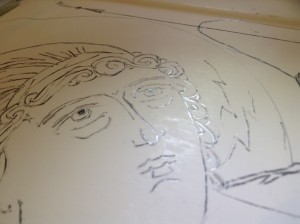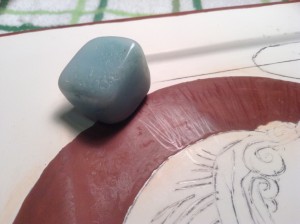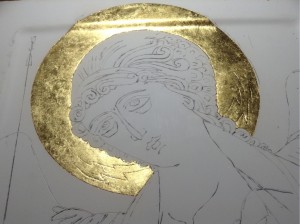(This is the fourth post in a series on writing an icon in the Orthodox Christian tradition. To start at the beginning, click here.)
Once the lines are drawn and inscribed on the gesso board, I’m itching to get my brushes and add some paint.
Not so fast. My teachers had a very specific step-by-step process for me to follow. Paint was still a few steps away.
First comes the halo. The seemingly endless process of the halo.
Maybe it is good that it takes time, this halo, this reminder of God’s glory shining through the saint’s life. In real life it takes a long while to become the kind of person who bears that light. Me, I’m still waiting.
The Circle
 First a perfect circle has to be inscribed around the head of the saint. The drawing had a tiny “x” on it to mark the place to put one needle-foot of a compass as well as marks to show the radius.
First a perfect circle has to be inscribed around the head of the saint. The drawing had a tiny “x” on it to mark the place to put one needle-foot of a compass as well as marks to show the radius.
(My teacher pointed out that using a compass is a good reminder to humility. We all need some help to draw a perfect circle.)
I fitted the outer foot of the compass with a second needle point, and carefully inscribed the circle, shoulder to shoulder.
The Clay
 Inside the circle, from the inscribed circumference to the hair and shoulders, I then had to apply “bole,” a mixture of red clay and glue made from rabbit hide.
Inside the circle, from the inscribed circumference to the hair and shoulders, I then had to apply “bole,” a mixture of red clay and glue made from rabbit hide.
And some distilled water. And just a bit of honey. An ancient recipe I’m sure.
But finally I was painting something: not paint but red clay, in a thick layer.
My teacher pointed out the significance of red clay. In the Hebrew of Genesis, the first human being, “Adam,” was made of clay, “Adama.” Red clay — the same root as “Edom.”
Previously trying to read an icon I saw with my eyes that the halo was gold. The saint shines with God’s light.
True enough.
Writing an icon, I now know with my hands that underneath the gold is the earthy red clay of human nature. Ahh… even truer. Saints are really human, created, earthy. Same as all of us underneath.
 Once the clay is dry, sanded smooth, and burnished to a gloss with an agate tool or polished stone, it will be ready for gold.
Once the clay is dry, sanded smooth, and burnished to a gloss with an agate tool or polished stone, it will be ready for gold.
Now that I think about it, that process too is full of significance for me.
The humanity of the saint starts out with red clay, just like anyone else. But then in the midst of life there is a process of transformation — sanctification, becoming like Jesus.
And the things that make me more like Jesus are often rather painful. Like sandpaper on the clay, the rough places of my life must be made plain. By friction and abrasion, not unlike that done by a burnishing stone, my life must become capable of bearing the light. Painful, but profitable.
The Gold
 Then gold, real pure gold, gets applied to the clay.
Then gold, real pure gold, gets applied to the clay.
You buy gold leaf in pricy little books, each sheet a couple inches square and about an atom thick.
Sneeze and it’s smashed to bits.
My teacher laid a single sheet of gold on a bit of wax paper. It stuck very slightly to the wax paper, making it easier to get into position.
I totally forgot about the wax paper when I was working on my icon of Archangel Gabriel. Oops. My gold went on in whispey fragments.
If you take up iconography, here’s my advice to you: Don’t forget the wax paper.
But the really cool thing, the most amazing part of the process, is the application of that gold.
- You have your gold ready.
- You put your face close to the clay.
- You breath, slowly, on the clay.
- Your breath warms the surface of the clay and glue mixture, making it tacky.
- You lay the gold down and press upon the wax paper.
And there it is. Shining like the glory of God from the gesso board.
Think again about Genesis. God made Adam from that red clay. The clay was lifeless — until God breathed into it.
Treasure in Earthen Vessels
So now, when I see the gold halo on an icon, I remember. Red clay, breathed on by God, with the result of life — glorious life, a gift from God.
I hope to be reminded of this as I bring my own life to God in prayer. There is an earthen vessel, always. May it shine like gold — what the apostle called treasure in earthen vessels.
And I hope to be reminded of this as I bring ideas to life in my more familiar types of writing. As the words come through my hands they are very much like clay. May God draw near and help them shine by the Spirit’s own breath, and do his work in the world.
————
Lent is coming! What a great time to focus on your prayer life.
Click the button to get info on my online prayer class for Lent…

Thank you, Gary, for a glimpse.